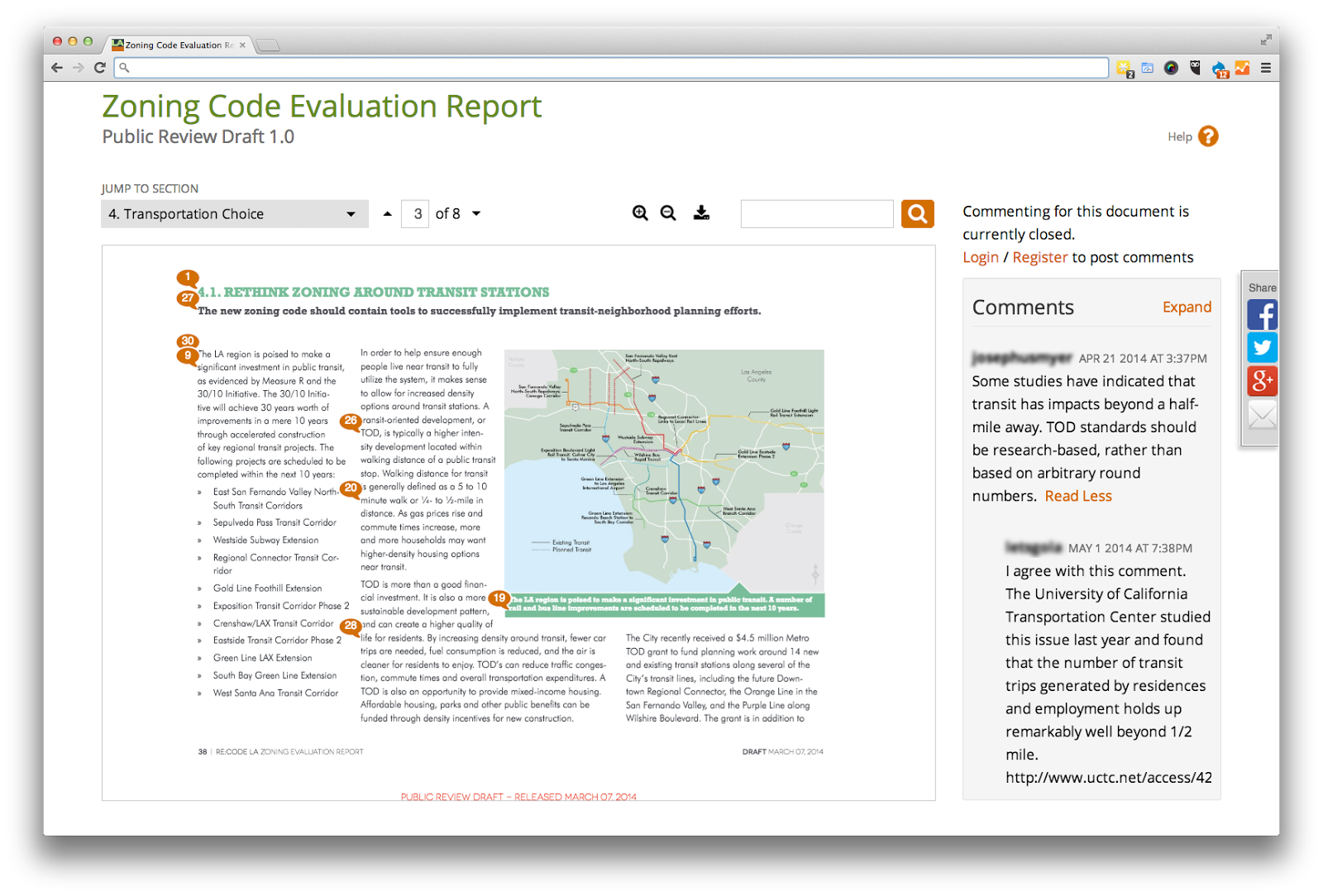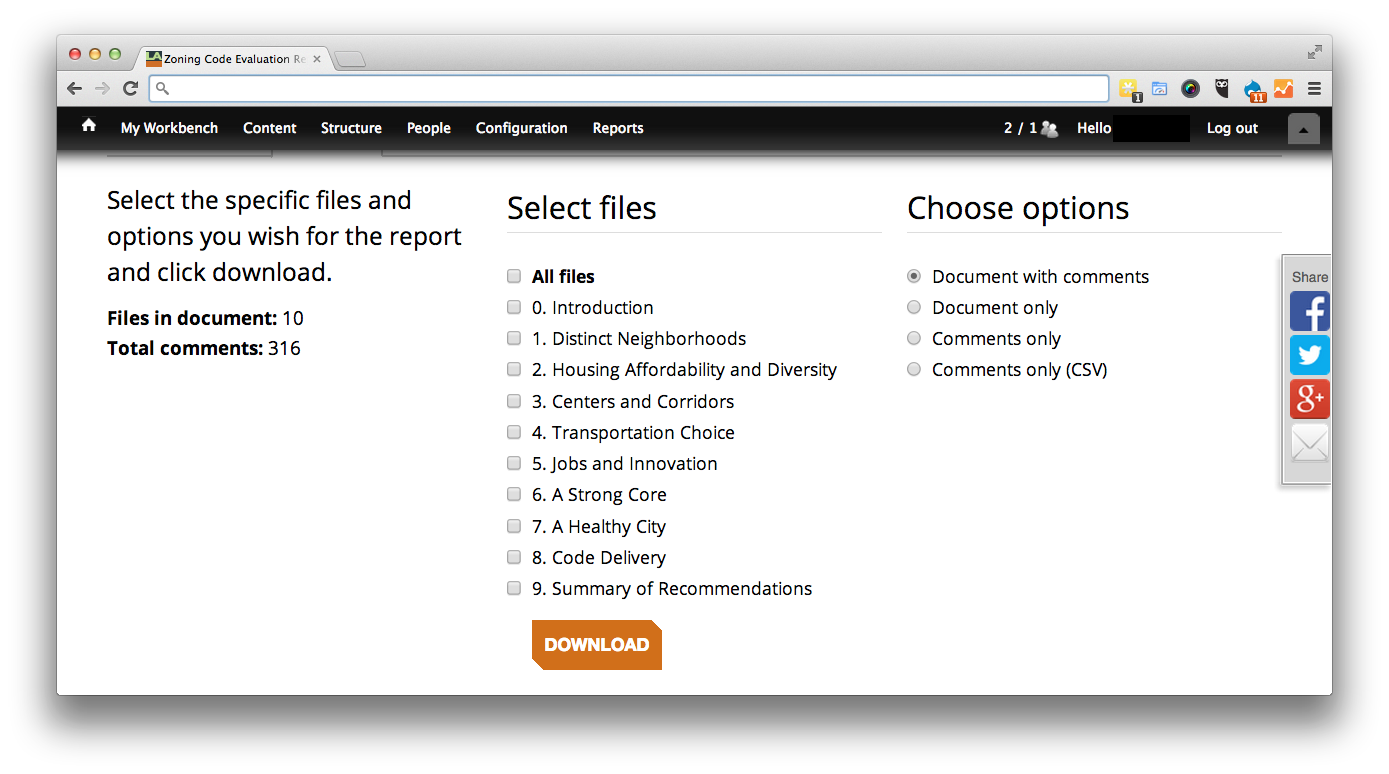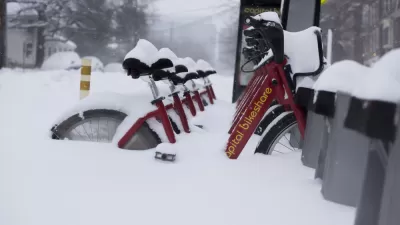How do you collect public comments on a web-based PDF planning document? It should be simple. But it isn't.

When Lee Einsweiler and Colin Scarff at Code Studio (Austin, Texas) completed a draft of the Zoning Code Evaluation Report for the city of Los Angeles' massive zoning code rewrite project, they ran into the same problem they've encountered dozens of times across the country.
It's a problem that planners run into every time we produce a draft document that requires public feedback.
How do you collect public comments on a web-based PDF planning document? It should be simple. But it isn't.
Usually, we publish the PDF on the web and invite residents to email in their comments. This is a messy and decidedly inelegant solution. Nobody likes to download and read a PDF, and when the comments come in, it's hard to track and match them up with the text in the document.
Erick Lopez is a tech-savvy city planner in the Los Angeles Department of City Planning, tasked with ensuring that the city's new zoning code is optimized for the web. He believed this was a solvable problem, and charged the team with coming up with a thoughtful solution that the city could use to collect feedback on the myriad of documents that would be produced through the five-year, $5 million zoning code rewrite project.
Erick was right. Code-named "MarkUp," the result is a very simple web interface that displays a PDF document by chapter, allowing visitors to "click" on any line in the document to simply add a comment.
Visitors can see the comments left by others and respond to their comments. To leave a comment, visitors login or use their Facebook or LinkedIn account.

Image 1: Screenshot of MarkUp on the recode.la website, with comments placed on top of the PDF.
The challenge arising from people who are argumentative or leave inappropriate comments was solved with the simplest possible use of crowdsourcing: If enough visitors mark a comment as abusive, the comment is unpublished until it can be reviewed by a staff member.
Lee and Colin recognized the opportunity to design a version of the report that would combine the original PDF with all the public comments. This enabled 316 comments received by the team to be automatically converted into a unified document that could be viewed alongside the text.

Image 2: Staff access a web-based interface which enables exporting of PDF documents with comments alongside the text to which it refers.
Based on the success of MarkUp to collect feedback on the PDF, the Planning Department and Urban Insight soon received calls from several other cities trying to solve similar problems. Based on these requests, Urban Insight has rewritten the system into a cloud-based project called OpenComment, https://www.opencomment.us.
By using the power of the cloud and open source software, cities, counties, and other organizations now have a relatively affordable, securely-hosted option to quickly upload PDF documents and empower visitors to comment on them on a website.
How do you collect public comments on a web-based PDF? Erick was right. This is a solvable problem: https://www.opencomment.us.
Chris Steins is the co-founder of Planetizen and Planetizen Courses and the CEO of Urban Insight, a technology consulting firm working with Code Studio and the Los Angeles Department of City Planning to develop the first modern, web-based zoning code.

Americans May Be Stuck — But Why?
Americans are moving a lot less than they once did, and that is a problem. While Yoni Applebaum, in his highly-publicized article Stuck, gets the reasons badly wrong, it's still important to ask: why are we moving so much less than before?

Using Old Oil and Gas Wells for Green Energy Storage
Penn State researchers have found that repurposing abandoned oil and gas wells for geothermal-assisted compressed-air energy storage can boost efficiency, reduce environmental risks, and support clean energy and job transitions.

Placekeeping: Setting a New Precedent for City Planners
How a preservation-based approach to redevelopment and urban design can prevent displacement and honor legacy communities.

Colorado Lawmakers Move to Protect BRT Funding
In the face of potential federal funding cuts, CDOT leaders reasserted their commitment to planned bus rapid transit projects.

Safe Streets Funding in Jeopardy
The Trump administration is specifically targeting bike infrastructure and other road safety projects in its funding cuts.

Six Reasons Why Housing Is a Human Right
Is housing a human right? A law professor shares six reasons why it should be, from its role in protecting other rights to global recognition and U.S. legal traditions. As public support grows, could housing be the next right written into law?
Urban Design for Planners 1: Software Tools
This six-course series explores essential urban design concepts using open source software and equips planners with the tools they need to participate fully in the urban design process.
Planning for Universal Design
Learn the tools for implementing Universal Design in planning regulations.
Heyer Gruel & Associates PA
City of Moreno Valley
Institute for Housing and Urban Development Studies (IHS)
City of Grandview
Harvard GSD Executive Education
Salt Lake City
NYU Wagner Graduate School of Public Service
City of Cambridge, Maryland





























